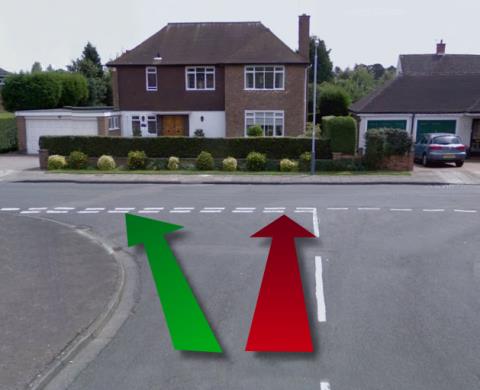I was on a lesson with a pupil a couple of days ago. She’s an older woman and it’s taken a long time to get her to where she is, and she’s still nowhere near test-ready. It isn’t her fault (or mine), but she just learns things very slowly, then has trouble remembering them. If you didn’t know her, you’d say she is just very lazy – she’ll happily go into a junction or a roundabout without even trying to engage her brain. (I should point out that she has come along enormously since we first started, so she’s getting there – but it’s not easy going).
Anyway, we were looking at the reverse around a corner exercise. Without going into minute detail, the way I have taught her to do it is to reverse back to the turning point, then to steer around (keeping the kerb in the same place in the mirror), then straighten up when the car is parallel with the minor road’s kerb line. It’s taken many months to get to this point – she simply could not steer in the right direction when needed (or even steer at all as the kerb approached the rear wheel), and that includes all of the different methods I’ve tried in getting her to follow the kerb line.
Last lesson, as is often the case on her lessons, we’d done this and after several attempts she could do it right. So this week the idea was to see if she could remember how to do it.
Try #1: We pulled up near the kerb, did all the checks, then started to reverse back to the turning point. After about 10 metres, I stopped the car:
Where are we going?
[Grins] I don’t know.
Can you see the kerb in the mirror?
[Grins] No.
Well, why are we still going backwards? [Open door and point down the road we’re supposed to be turning into, which is now almost in front of us]
[Grins] Well, I couldn’t see the kerb when I first stopped – I hadn’t gone far enough forward.
[Expletives removed]
Try #2: She positioned it properly this time. We reversed to the point of turn and did all the checks. She turned the wheel about one turn (which is OK), paused for a moment, then took it to full lock (which isn’t OK). As the kerb flew towards us (relatively speaking), she started taking off small amounts of steering to try and control it. We hit the kerb almost immediately.
Why did we hit the kerb?
[Grins] I didn’t steer the right way.
No, your steering was fine and you were trying to do the right thing. How much turn do you usually need to start with for a corner like this?
One turn.
[Expletives removed]
Try #3: She did it perfectly.
Why the hell [word changed from the one I actually used] didn’t you do it like that the first time?
Bear in mind that I get on with this pupil really well, and we have a good laugh – which we were doing during this manoeuvre – so don’t take the above out of context or too literally.
When you get one like this, though, it can be really frustrating and demoralising. And that’s true for both the pupil and the instructor. When we first started this manoeuvre (and all of the others), she simply could not steer the right way. On the one hand, identifying the problem was easy – she consistently steered in exactly the opposite way required whenever she went into reverse. On the other hand, fixing it was a nightmare. I could get her to tell me which way she was going to steer, but the instant we went ‘live’ she’d steer the wrong way again. Even now, occasionally she’ll do it wrong if she isn’t thinking.
A few years ago I had a young lad who I thought would never make it. He just couldn’t control the clutch and I couldn’t seem to do anything to fix it – and I’d tried lots of different ideas. Then, one day, we ended up in a cul-de-sac near his house. It was one of those roads which has a circular space at the end with houses arrayed around it, but I had an idea. We spent around forty minutes just going backwards and forwards in a continuous ‘turn in the road’ fashion. From that moment on he became a great driver and passed his test easily.
So – even if it kills me – I will teach her to drive properly!
EDIT 20/06/2010: We had another lesson yesterday – here’s a specific example of the problems I am dealing with.
We were driving along, and I said “at the end of the road, turn left”. Now, bear in mind she has had around 60 hours of lessons. I had to tell her to check her mirrors and indicate. Then – as we didn’t appear to be slowing at all – I had to dual her at the junction, because she hadn’t looked for any traffic on the major road. The picture below shows where we ended up (red arrow), compared with where we should have been.

End Of The Road
I pulled her over and asked why she had done it. At first, she said she didn’t know. But I pushed harder, explaining that it was important to find out why it went wrong and this is what she said:
Well, to be honest, I got a bit confused because I didn’t realise that it was the end of the road.
I mean, what do you do with someone like this?
(Hint: Anyone who is similarly confused, the white dashed lines, kerb on the opposite side, and the big thing – usually known as a “house” – are a bit of a give away).



